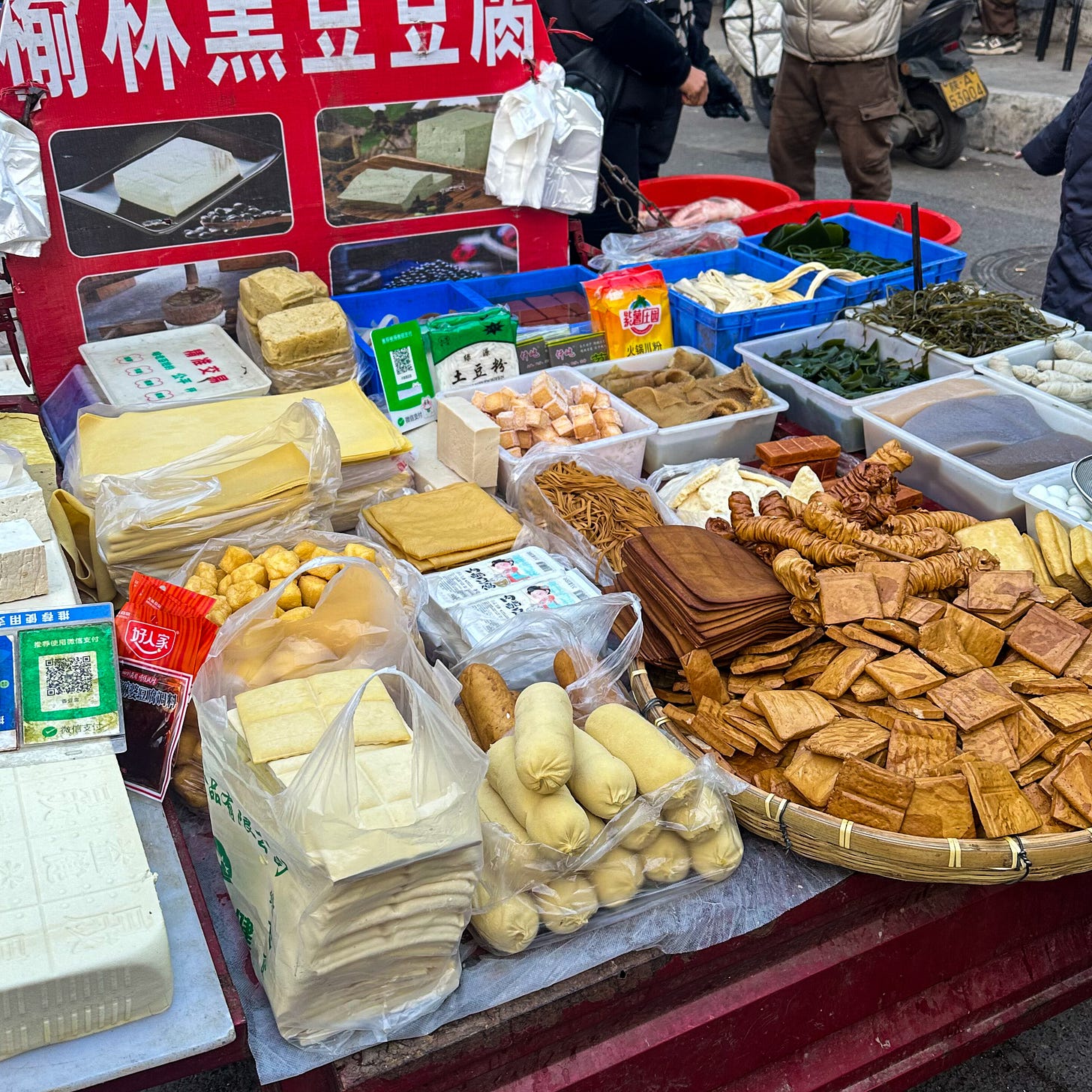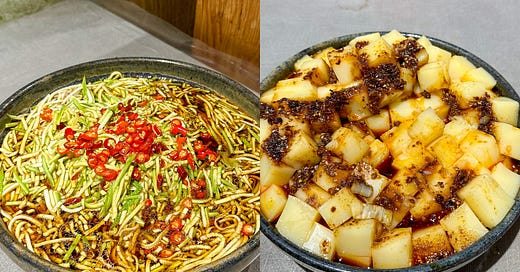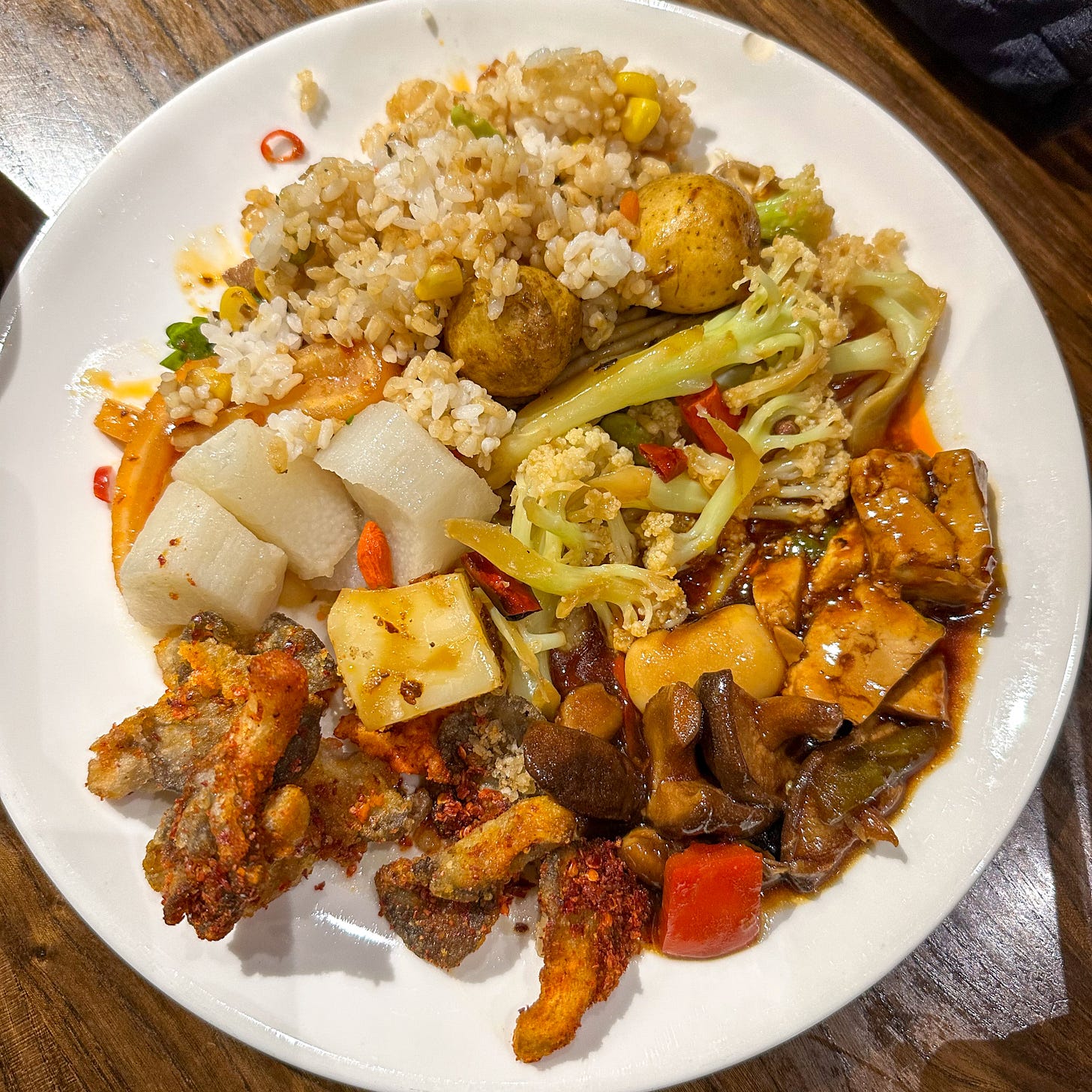Eating Vegetarian Sichuan Food in A Buddhist Temple
and a brief history of vegetarianism in Chinese cuisine
Every January, the conversation turns to embracing more plant-based diets and veganizing food. Growing up in Sichuan as an omnivore, I consumed a lot of vegetables and naturally vegan ingredients like tofu products. Cooking such things never felt like forcing a lifestyle shift or trading the taste, as there were always numerous recipes to explore. Right now in winter, everyone in Sichuan is hyped about seasonal pea shoots, cai tai (rape shoots) and er cai (mutant mustard).
I returned to Wenshuyuan (文殊院), a Buddhist temple/monastery nestled in the heart of Chengdu near where I had sweet-water noodles last year. I came here to try their su zhai (素斋, Buddhist vegetarian food). The meal was both inspiring and delicious, showing the possibilities of plant-based cooking within the diversity of Chinese cuisine.
Vegetarian buffet at Wenshuyuan
Opening up for the public in 1984, the monastery kitchen transformed into a vegetarian restaurant and tea house called Xiang Yuan. Situated in a tranquil bamboo yard within an old two-story building, it offers a lunch buffet, hotpot, menu dishes, and even cooking courses. The lunch buffet costs 35 yuan (about 4.5 euros) per person, with an incentive for returning an empty plate - a 5 yuan refund to reduce food waste.
The buffet includes sections for cold and warm dishes, grains and noodles, pastries, soups, and desserts. Some naturally vegan options include five-spiced tofu, yellow liangfen, cauliflower, pumpkin, and yam, while others incorporate mock meat. Cold-dressed mock pig ears are made from konjac starch, giving a realistic look and delightful QQ texture. Mock meatballs, supposedly made with soy protein and starch, are bouncy and firm, pairing well with the natural sweetness provided by winter melon, jujube, and goji berries. Surprisingly, contrary to my perception of a monk’s bland diet, some dishes pack a punch, for example, the cold soba noodles loaded with fresh chilis.
Vegetables take center stage, showcasing an array of textures and flavors, all without the use of garlic and scallions. Relying on high-quality seasonal ingredients, sauces and spices, each dish bursts with flavors.
Watch me trying the buffet here!
A brief history of vegetarianism in Chinese cuisine
Similar to Wenshuyuan, vegetarian dining in Buddhist temples began to flourish in Sichuan during the 1980s. Eaters of all faiths were drawn to this new and refreshing food experience. Many Chinese food experts argue that vegetarian cooking has long been an integral part of Sichuan and Chinese cuisine. Buddhist temples across China, not just in Chengdu, offer regional cuisine-focused meals, extending even to places like Berlin and Los Angeles.
Vegetarian eating1, chi su (吃素), is deeply intertwined with Buddhism in Chinese culture. Early Chinese Buddhists refrained from consuming the "five pungent" ingredients (wu xin, 五辛), including garlic and scallions, a practice still followed at Wenshuyuan's buffet. Around the 5th century in Northern and Southern dynasties, Buddhist vegetarianism expanded from eating clean meat2 to a meat-free diet, strongly promoted nationwide by the emperor of Liang. Vegetarianism became popular among Han Chinese practitioners of Mahayana Buddhism due to the political endorsement.
Early vegetarian recipes
Around the same period, the earliest eleven vegetarian recipes were recorded in the book Qimin Yaoshu (齐民要术, 6th century), featuring ingredients like mushrooms and eggplants, common substitutes for meat in modern vegetarian cuisine. Vegetarian cuisine diversified into three primary categories: imperial, monastic, and civic, each influencing the others throughout its evolution.

By the Qing Dynasty, vegetarianism became highly developed. Vegetarian restaurants emerged, and monasteries developed delicate mock meat dishes. The imperial kitchen even dedicated a department for vegetarian cooking. Recipes thrived during this era, including dishes like tofu skin-based vegan chicken and almond tofu, which remain widely enjoyed today.
A late Qing Dynasty cookbook specializing in vegetarian cuisine, Sushi Shuolve (素食说略), recommends using local produce and lighter cooking methods, such as stir-frying instead of deep-frying, and incorporating vegetable stock for umami. The author stressed that good cooking techniques were crucial in promoting vegetarianism.
One of the old cookbooks I recently acquired, includes 92 recipes from temple cuisine, with mock meat being a major part. Seitan, winter melon, and potato are used to mimic various meat parts like cubes, pork belly slices, and knuckles, while tofu skin often stands in for mock beef and poultry.
In contemporary China, vegetarianism has transcended its roots in religious practice to become a lifestyle choice. While earlier generations embraced vegetarianism due to Buddhist influence, today we witness a surge in temple visits among younger generations during a gloomy economy. Visiting a vegetarian buffet might solely aim for the experience and taste, yet it provides an opportunity to reconsider our connections with food and culture, especially at a time when eating tofu can be both a trend and an insult.
My vegan and vegetarian recipes
Many of my recipes are naturally vegan, for example:
Braised tofu with Brussels sprouts
vegetarian recipes:
In most of the texts, su is translated to “vegetarian”, however part of them are also considered vegan.
Jing rou, 净肉, refers to meat obtained from animals slaughtered out of sight, unbeknownst to consumers, and not specifically intended for consumption."











As a vegetarian, I loved reading about this. Thank you.
I love Chinese mock meat tradition! Are you still in Sichuan?